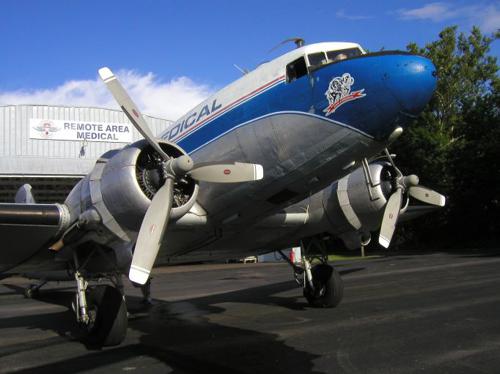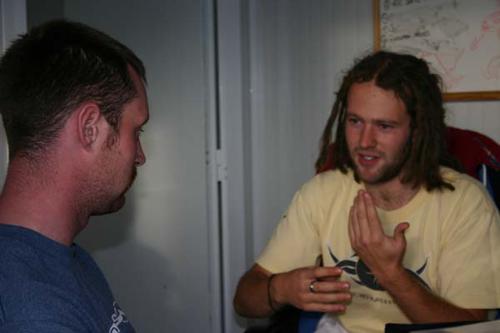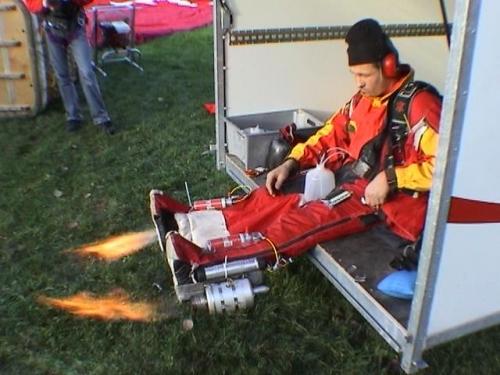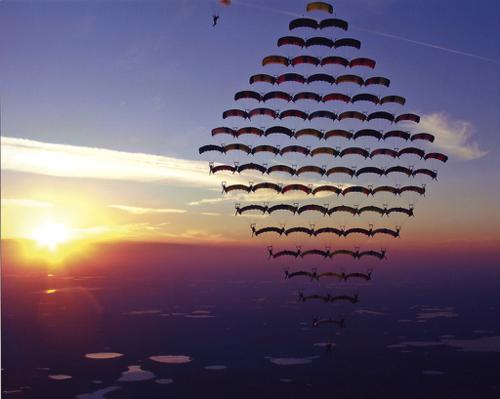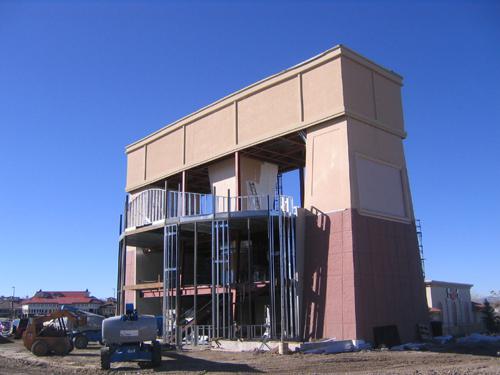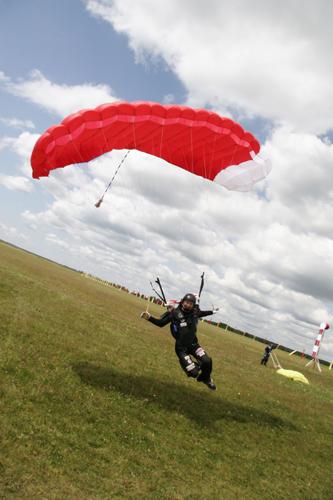Triax Productions' new Triax T-Stake
The Triax T-Stake is a revolutionary new packing multi-tool for both B.A.S.E. jumpers and skydivers. Designed by Triax Productions, the creators of the popular "Continuum" B.A.S.E. jumping DVD series, the Triax T-Stake is of use to anyone who packs their rig outdoors, and is trying to maximize the safety and heading performance of their canopy openings. A full explanation of the Triax T-Stake's features and a link to a short informational video clip can be found below in the article.
The Triax T-Stake
As the name implies, the "T-shaped" Triax T-Stake is a tool designed to make your B.A.S.E. and skydiving packing experience easier, faster, neater, and more organized by combining all of your tools into one. "We felt that this product could provide a 'missing link' in the jumping community," said Kenyon Salo, one of the B.A.S.E. jumpers that came up with the idea to design the tool earlier this year. "The Triax T-Stake was a lot of fun to design because we had full creative control from the bottom up, and being end users of the Triax T-Stake, we were able to base our design criteria on literally thousands of pack jobs worth of experience." Salo later added; "I really think that the world is a better place because of the Triax T-Stake. I know it's helped me become a better person!"
Design Features:
A specially designed "T-shaped" stake offering many different ways to secure your rig (or multiple rigs) while packing
Light, durable and compact for easy use and mobility needs.
Both 7mm (for most skydiving rigs) and 9mm (for most BASE jumping rigs) built-in wrench slots for your French (rapide) links for an easier time of changing slider configurations.
A classic bottle opener for that cold beer (or soda?) after a long day of jumping.
Bridge Day 2005
Triax Productions officially unveiled the Triax T-Stake in October at Bridge Day 2005 in Fayetteville, West Virginia, one of the few legal B.A.S.E. jumping events held in the United States each year. Overall, the Triax T-Stake was found to be a huge success at Bridge Day. Jumpers were seen using it all over the packing areas properly staking their leg straps, three rings or risers to securely anchor their rig for supreme line tension, at the same time providing adequate line separation while packing. During the event, the bottle opener function of the Triax T-Stake was put to the test with an estimated one thousand beers opened in a two-night period. Additionally, the crafty Bridge Day 2005 B.A.S.E. jumpers discovered yet another use for the Triax T-Stake-shot-gunning beers.
Bridge Day Video Fest
The pressure was on at this year's Bridge Day Video Fest for Triax Productions to defend their first place win in 2004. Although their entry did not win them a prize, as a way to introduce a little humor into a night of some serious B.A.S.E. movies, Triax Productions debuted their "T-Stake Infomercial," (directed and edited by Chris Pope). The entry went over as an audience favorite and has since become a cult hit. Popular demand has dictated that Triax Productions make their "T-Stake infomercial" available online, and it can now be viewed on the company's web page, http://www.triaxproductions.com/ [The infomercial is in Windows Media format and takes about a minute to download for an average broadband connection] Triax Productions would like to offer hearty congratulations for the winners at this year's Video Fest!
The Triax T-Stake and Skydiving
Although designed primarily for B.A.S.E., skydivers have also taken a liking to the Triax T-Stake. Not all skydivers have the luxury of being able to pack indoors all of the time, and for some, particularly on the boogie or swooping circuit, it's a rarity. The Triax T-Stake works equally well for skydiving rigs as it does for B.A.S.E. rigs, making the whole process of getting on with your pack job faster and cleaner, instead of scrounging around for a weight.
Where to see the Triax T-Stake
If you weren't lucky enough to be at Bridge Day this year, and want to get more information on purchasing a product, the Triax T-Stake, along with the company's DVD releases and apparel such as T-shirts, hoodies, and chick-tees have been made available for purchase at the Triax Productions web site.
About Triax Productions
Triax Productions was founded in 2002 and is made up of Colorado B.A.S.E. jumpers/skydivers Damian Doucette, Chris Pope, and Kenyon Salo. They offer stock footage and complete package action/adventure videography services on their website, counting aerial stunts and camera operation among their many talents. Triax Productions has also been producing some of the world's best B.A.S.E. jumping DVD/videos on the market, including their popular "Continuum" and "Continuum II: Tales From the Edge" DVDs, as well as the Bridge Day event videos for both 2004 and 2005. The Triax crew has just released the 2005 Bridge Day DVD and is currently in production of "Continuum III," tentatively slated for release in September/October of 2006. Plans for the Bridge Day 2006 event DVD are also in the works.
FFI/contact: http://www.triaxproductions.com/


